How To Change A Black Background To Transparent In Photoshop
Knowing how to make whatever color transparent is a useful skill to have when using Photoshop. Often in projects, the design or edit requires elements from an paradigm to be added to other designs with transparent attributes. Luckily with the help of selection tools similar the Magic Wand tool and the Select Colour feature, turning color into transparency is pretty straightforward.
To make a color transparent in Photoshop, get to Select > Colour Range. Click on the colour you want to remove, then hold Shift to add additional colors to the selection. Adjust the Fuzziness slider until your subject is white and then click OK. Lastly, press Delete to make the selected colors transparent.
How To Make A Color Transparent In Photoshop
Making a colour transparent is not equally hard equally it may sound. Using color-based selections, you can easily select parts of an image and brand them transparent by deleting or masking the rest of the layer.
Selection 1: The Magic Wand Tool
The magic wand tool allows you to make selections based on color and tone. This tool is ideal for removing monochromatic areas or areas that are very similar in tone. It is also easy to utilize when the object you lot want to go along is a different tone to the background you are removing.
In order for the magic wand tool to work at its all-time, yous demand to adjust its settings properly. Hither, you volition acquire how to conform the magic wand settings so that you are able to use the tool more efficiently. To explore the Magic Wand tool options, first, click the tool icon from the toolbar.
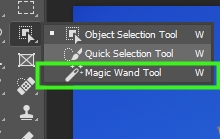
One time you select the tool, the Options bar will display all the magic wand tool options.

By default, when the magic wand tool is selected, Photoshop enables the new selection option. Thus, when you click an area of an image, the tool will select the color tones you clicked on.
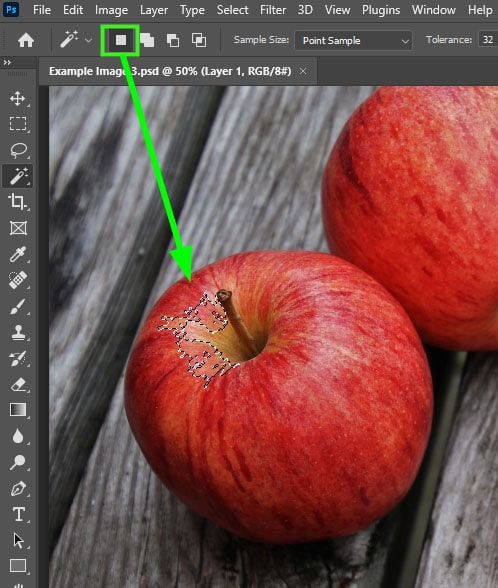
To select an additional area, click on the second square icon on the Options bar known as the Add together To Option setting. When you practice this, a plus sign icon will appear next to the magic wand. The shortcut for this option is belongings in Shift and clicking if yous don't want to make changes up the upper bar.
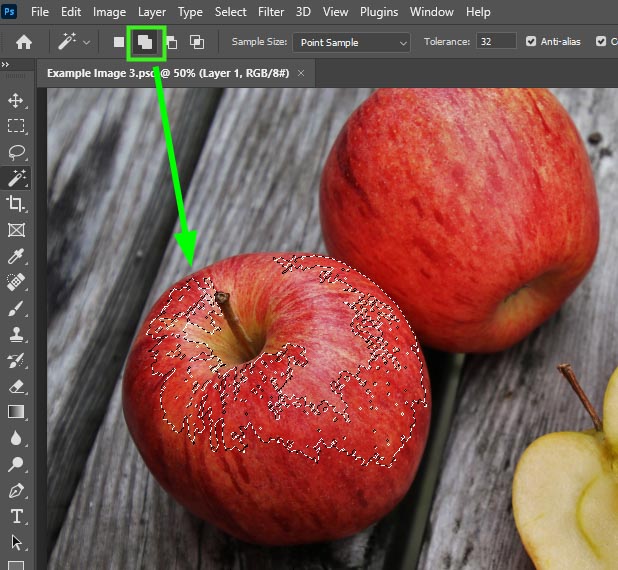
To decrease an area from your selection, click on the third square icon. The shortcut for this action is Alt (Win) or Option (Mac).
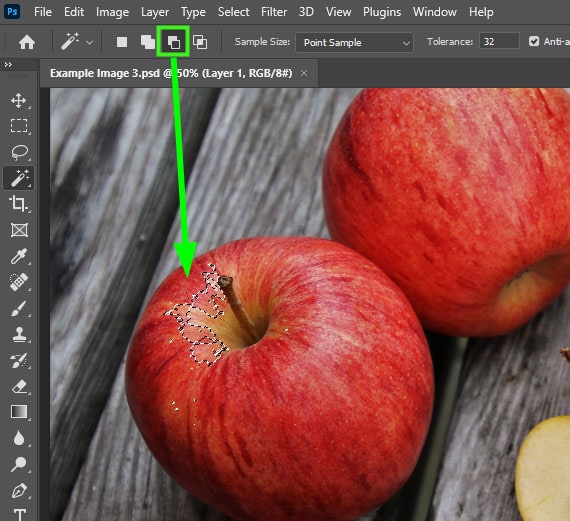
If yous want to select the intersection between two selections, click the last foursquare option.
The Sample Size pick is set to Point Sample past default, which means whatever selection you make will be based on a unmarried pixels color. That'southward why the magic wand tool merely selects a minor expanse when I click my image in the example beneath. Its sample is extremely specific, therefore information technology'southward pickier with what other colors it selects.
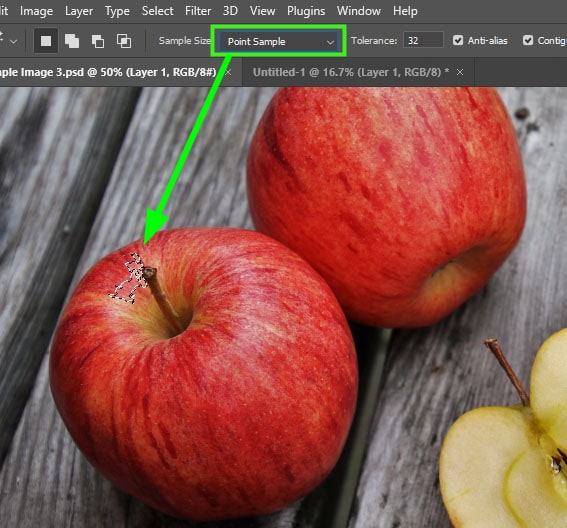
Just the sample size menu allows you to increment the sample size upward to 101 past 101 Average, which samples more than pixels for the selection. This makes your job easier if yous intend to select the largest number of pixels from similar tones.
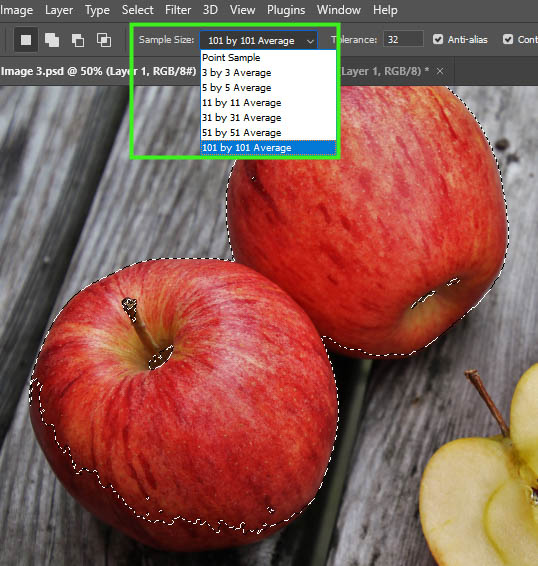
By default, Tolerance is set to 32 pixels, which means the magic wand tool selects pixels in the range of 32 tones below and to a higher place the pixel color yous selected.

Anti-alias reduces selection imperfections, such equally jaggedness and sharp edges. You should always make certain this option is selected.

Contiguous is another useful option that yous will constantly employ. Select this selection if you simply want to select pixels of similar tones that are directly side by side to each other. While face-to-face is enabled, the tool will only select colored pixels that are touching, while excluding whatever ones that are isolated from your original sample.
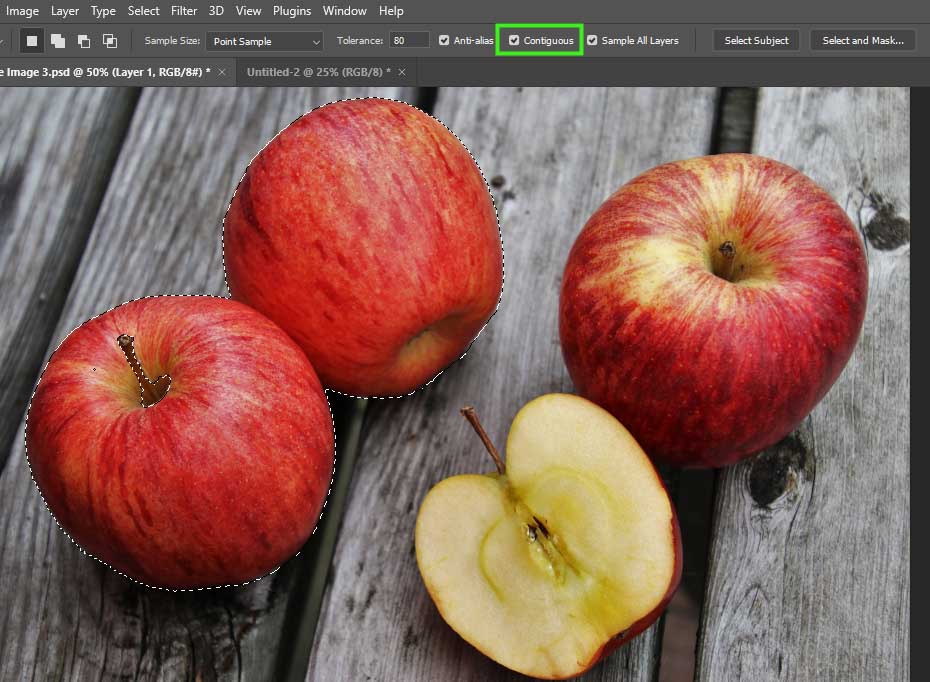
If you uncheck this choice, the magic wand tool volition select pixels of similar tones from your entire image rather than colored pixels that are touching.
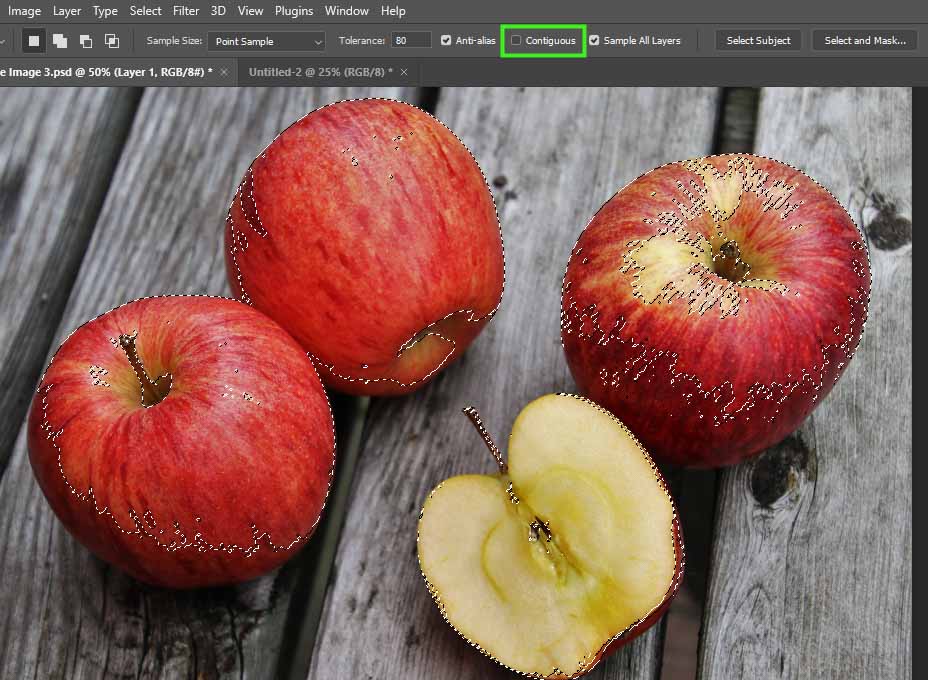
Finally, Sample All Layers is a useful option for making selections with the magic wand tool in ii or more layers.

This manner, yous tin brand selections on all the layers in the Layers console at in one case.
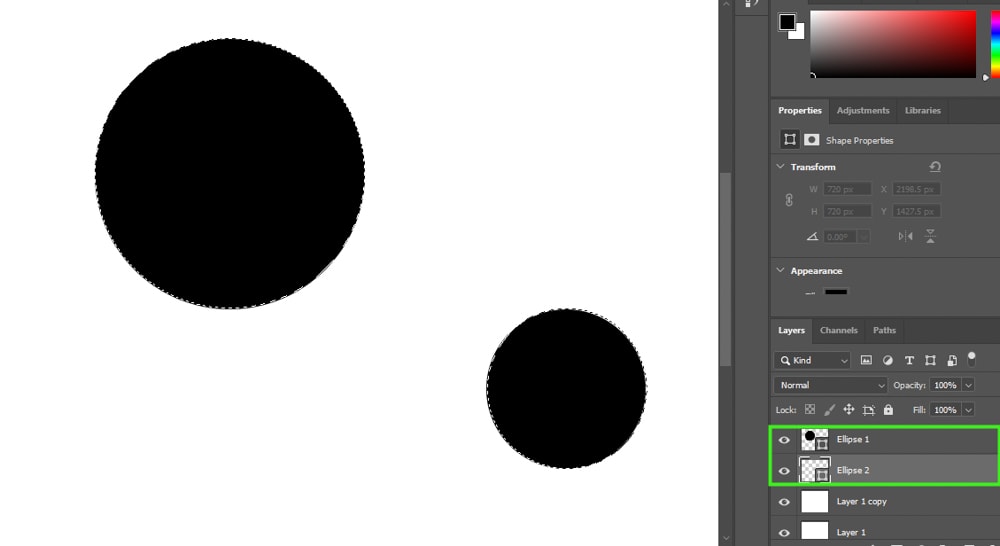
Now that y'all know all the magic wand tool options, let's wait at an case of how to make a color transparent using a unlike paradigm.

Click the magic wand tool from the toolbar (Westward) to start making your option.

Side by side, adjust the settings in the Options bar. For my prototype, I want to increase the tolerance, so that more than pixels are selected since the background has different tones.
For instance, the area near the sunflower is brighter than the area near the edges of the image. Equally I want all blue pixels gone, no matter what tone they are, I set the Tolerance to 78.

Then, I volition cheque Anti-alias because I want to reduce the risk of imperfections in the object's edges.

Next, I will uncheck Contiguous since I want all blueish pixels gone, no matter where they are in the paradigm. By adjusting this setting, the magic wand will select similar pixels from the whole image. I volition likewise uncheck All Layers since I only have one layer in my Layers console.

With the settings adjusted, I volition click anywhere in the blue area of the epitome. The pixels containing the tones within the chosen range are now selected.
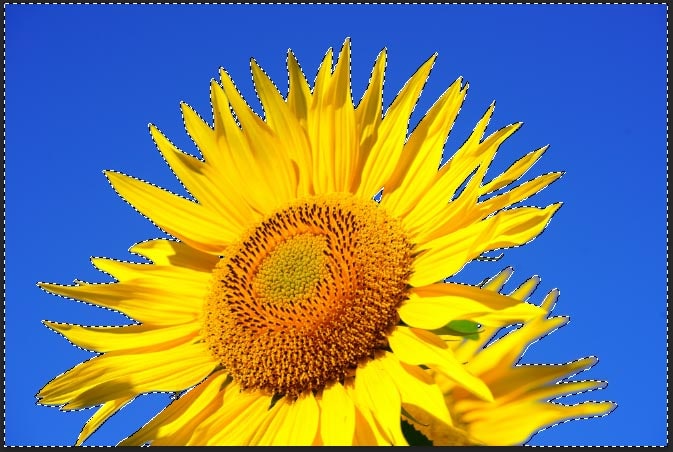
Notice every part of the blue background was selected. Since the magic wand settings were adjusted, I don't need to subtract or add together any more than content to the selection.
Now, to make a selection transparent, y'all need to either delete the content you selected or create a layer mask. The difference is that if you delete the content, you lot can't refine your selection.
If you're non worried most refining your selection, press Delete on your keyboard.
Nonetheless, if your selection may demand refinements, you should create a layer mask instead. To do that, invert the option by pressing Control + Shift + I (Win) or Control + Shift + I (Mac).
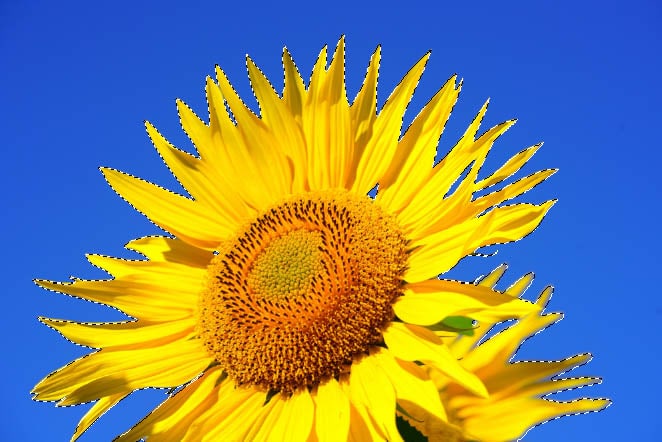
This is necessary because the layer mask shows content within a choice and hides all content exterior the pick.
Now, create a layer mask by clicking the layer mask icon at the lesser of the Layers panel.
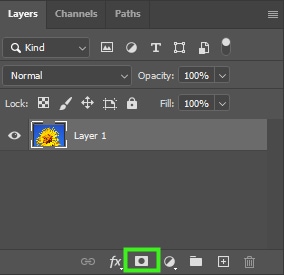
This will create a layer mask and make the unselected content transparent, which in this example is the heaven.
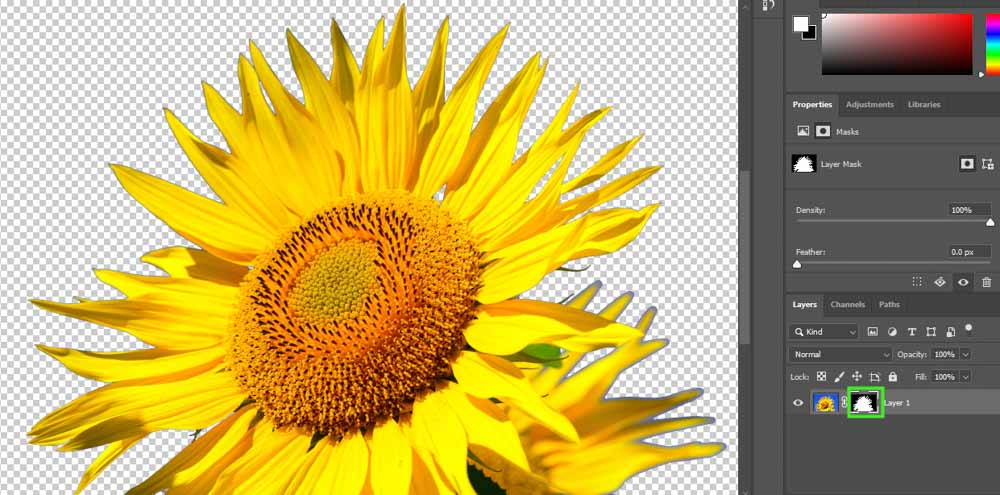
Although the layer mask does a good job making the expanse you selected transparent, you still demand to refine your selection in well-nigh cases to get rid of colour fringing and other option imperfections. To do that, double-click the layer mask.
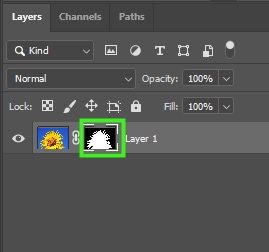
This will bring up the Select And Mask workspace, where you lot can find several options to refine your option.
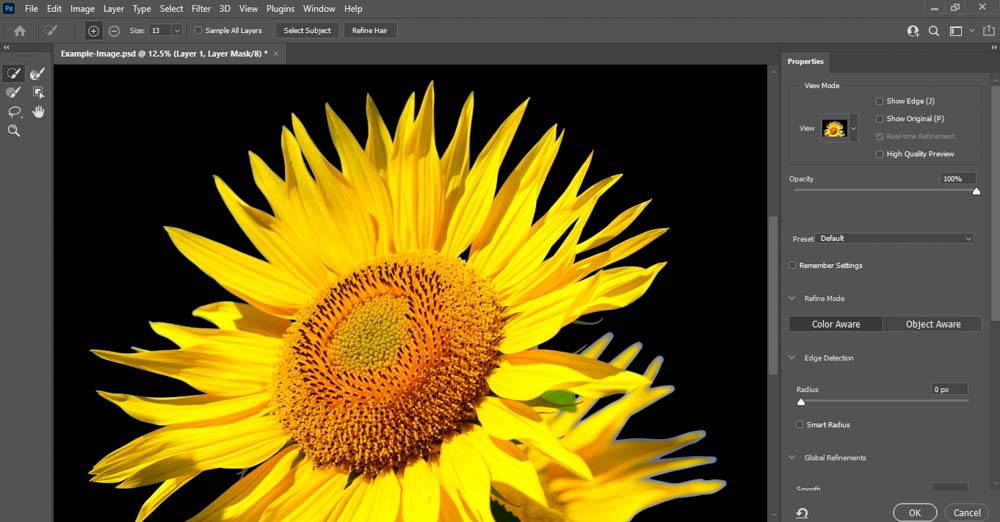
For my paradigm, I clicked the Refine Border castor tool on the left side of the console, which is an excellent tool to refine the edges of selections with fur, hair, feathers, or even flower petals. I then painted over whatsoever areas with fringing to remove any unwanted pixels surrounding the sunflower.

When you're finished refining your selection, click ok to exit the Select And Mask workspace.
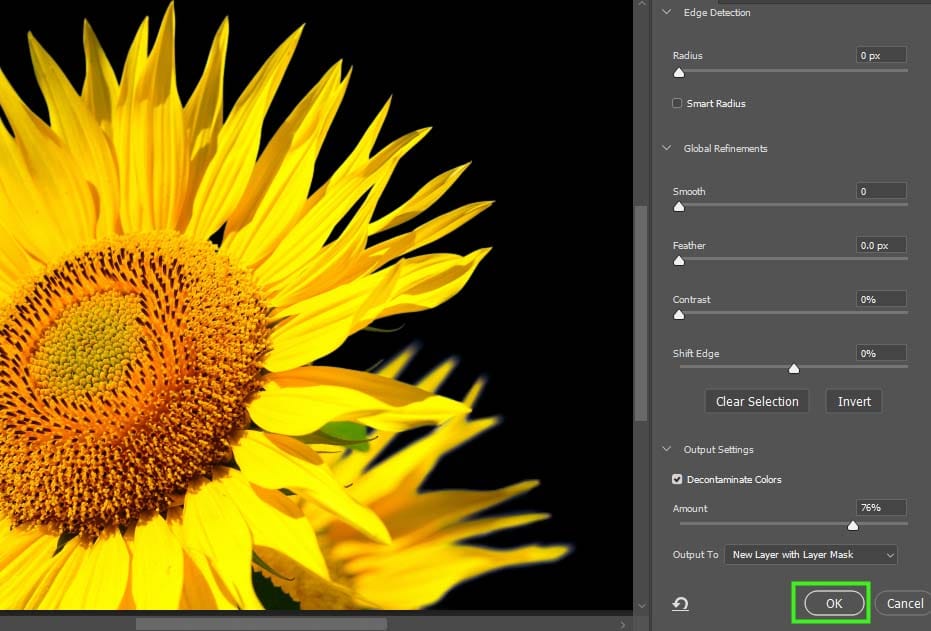
Then, you can go back to the canvas, where you can do many things to your epitome, such equally changing its background or fifty-fifty consign it as a PNG file to save your transparent background.
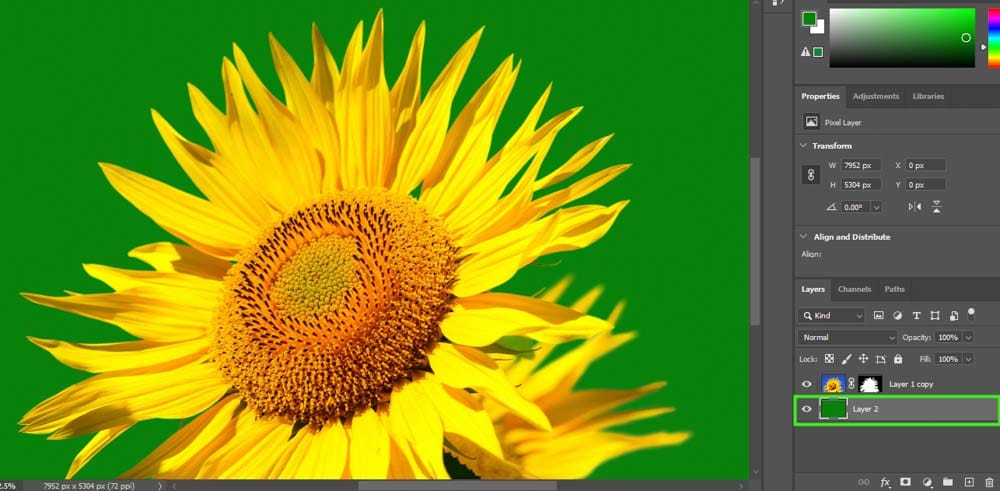
Choice 2: Select Color Range
You can besides make a color transparent using the color range tool. This selection tool is very similar to the magic wand tool, but information technology offers other advantages. The color range tool allows you to select a wider variety of tones in your image past sampling colors and turning them into a selection. In some cases, it proves far more convenient than the magic wand tool.
The principal similarity betwixt the Color Range tool and the Magic Wand tool is the number of settings available to refine the selection.
To use the color range, bring a photograph into Photoshop with a monochromatic surface area or an surface area with like tones that y'all want to remove.

Then get up to Select > Color Range.
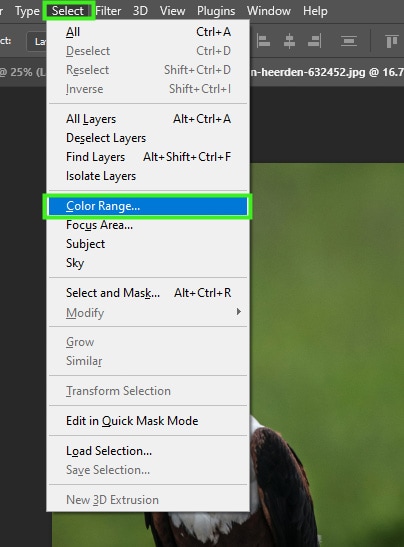
Once the colour range panel opens up, you need to suit some settings for the tool to work efficiently. First, cull Sampled Colors from the Select card.
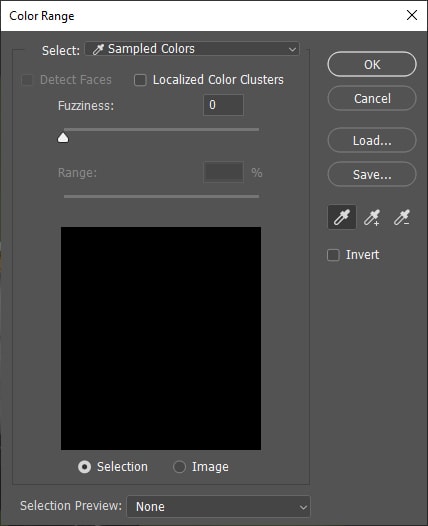
This will enable the eyedropper tool, then you tin can sample a color from the area you want to make transparent.
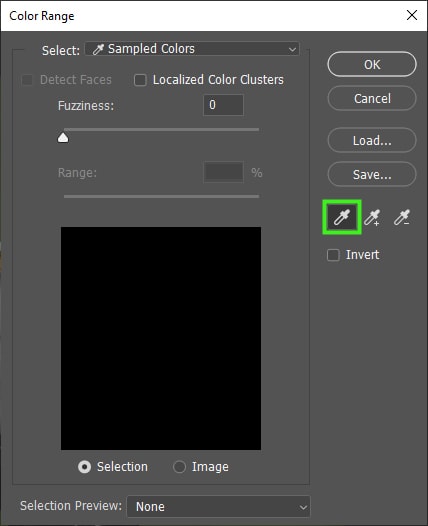
Next, it's time to adjust the Fuzziness. Fuzziness controls the range of colors that the eyedropper tool tin sample.
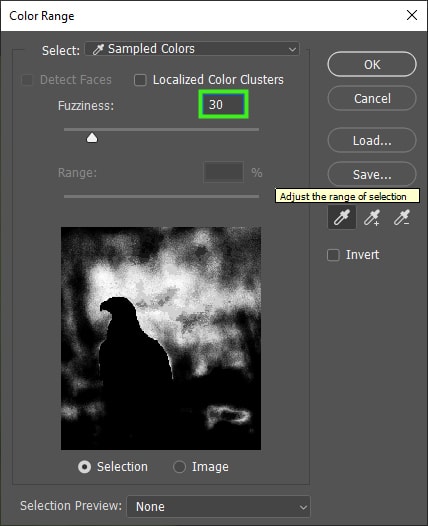
Fuzziness at 30 means Photoshop will select pixels from the same color as the one you sample and pixels that are 30 tones brighter and 30 tones darker from the color you lot sample.
Fuzziness is similar Tolerance to the magic wand tool. The difference is that you tin can change fuzziness any fourth dimension while making a selection and even after it, which gives you more control while making your selections.
Some other setting you may want to change is Capsize. By checking the Invert checkbox, the area y'all want to brand transparent will turn black and the area you want to make visible will plough white, only like it happens with a layer mask.
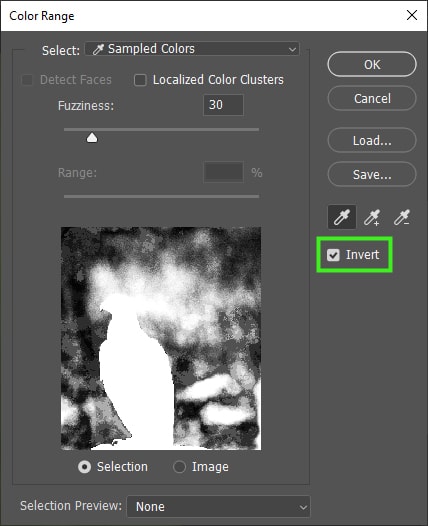
Selection Preview controls what you see on the sheet. If you're already seeing your selection in the preview window in the colour range panel, it'south better to set Selection Preview to none. Otherwise, you tin choose from 1 of the option preview modes available.
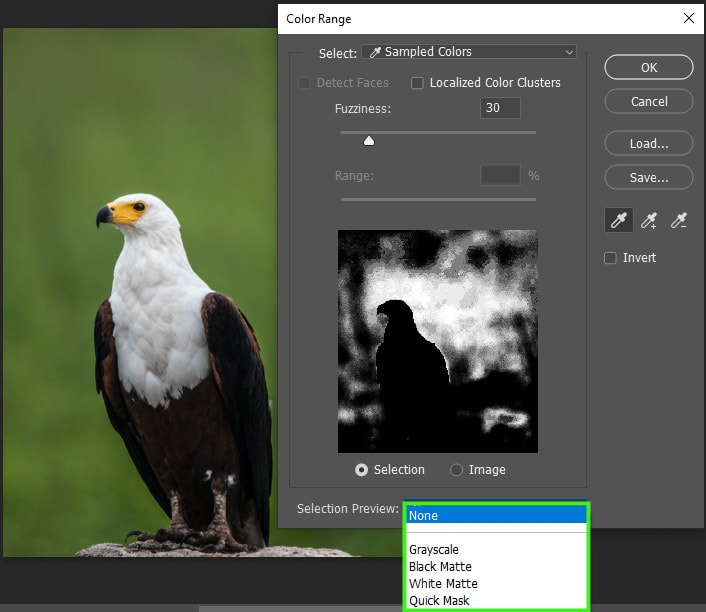
Later on adjusting all the color range settings you demand, you lot can start sampling the colors you want to brand transparent. To do that, simply click the surface area you lot want to make transparent.
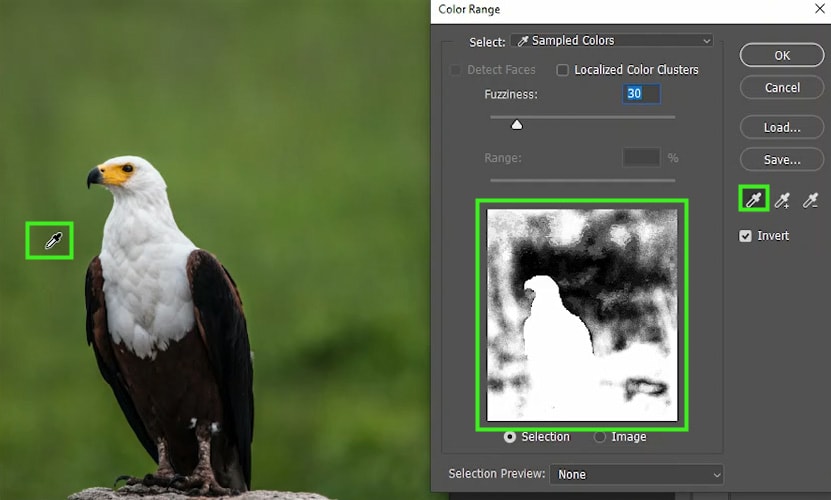
You tin can add more colors to the choice past pressing Shift while clicking on the other regions of the image yous desire to add. When you lot press Shift y'all will detect a plus sign icon will appear next to the eyedropper tool. You can too press Shift while dragging effectually the image with the eyedropper tool to add more content to the choice.
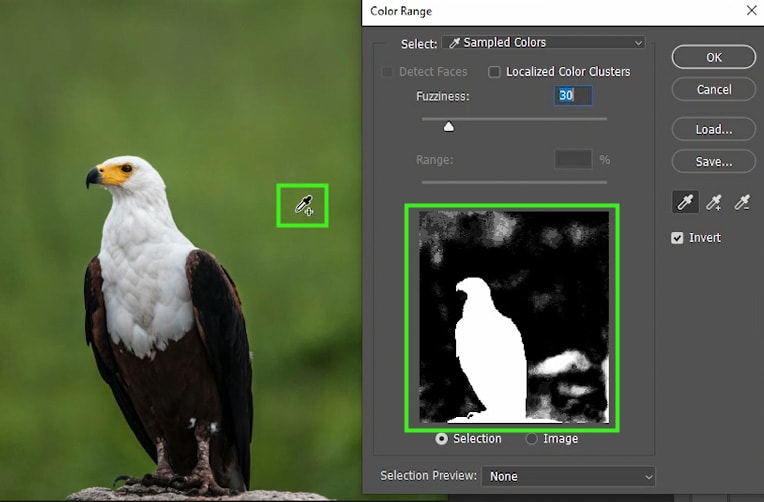
The goal here is to make the content you want transparent plough black, and all content you want to make visible plough white in the preview window.
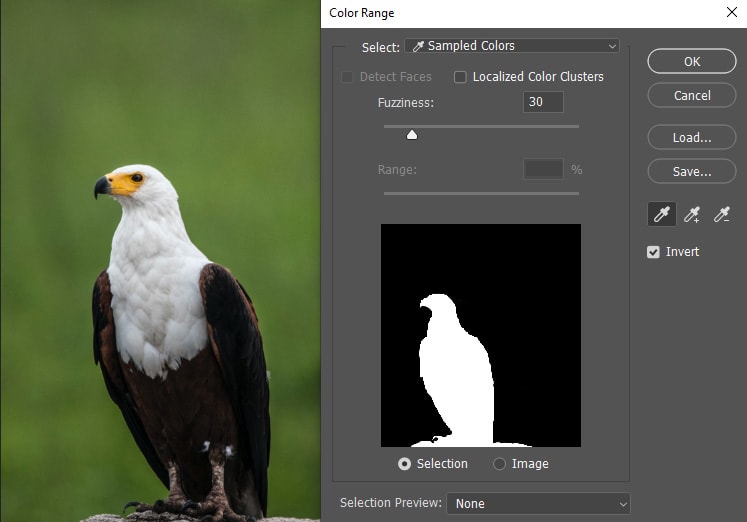
When that happens, click OK to exit the colour range console and create the selection.
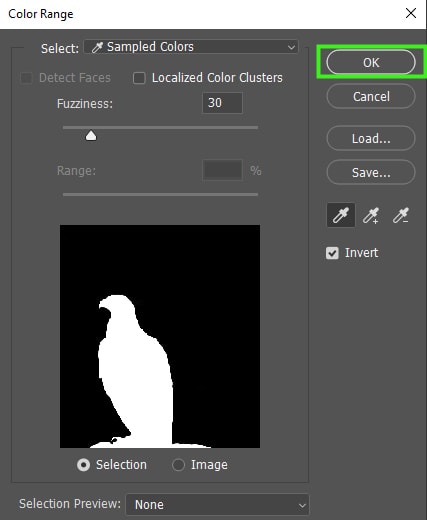

Now, with your prototype layer selected, click the layer mask icon at the bottom of the Layers console to create a layer mask and make the colour you selected transparent.
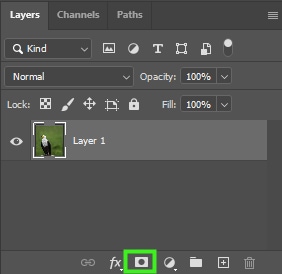
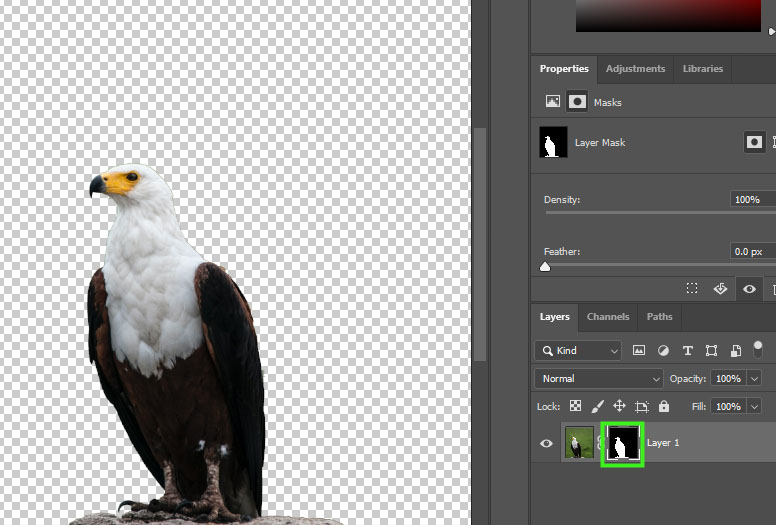
Later making your option transparent, yous can double-click the layer mask to open up the Select and Mask workspace where y'all can refine your selection.
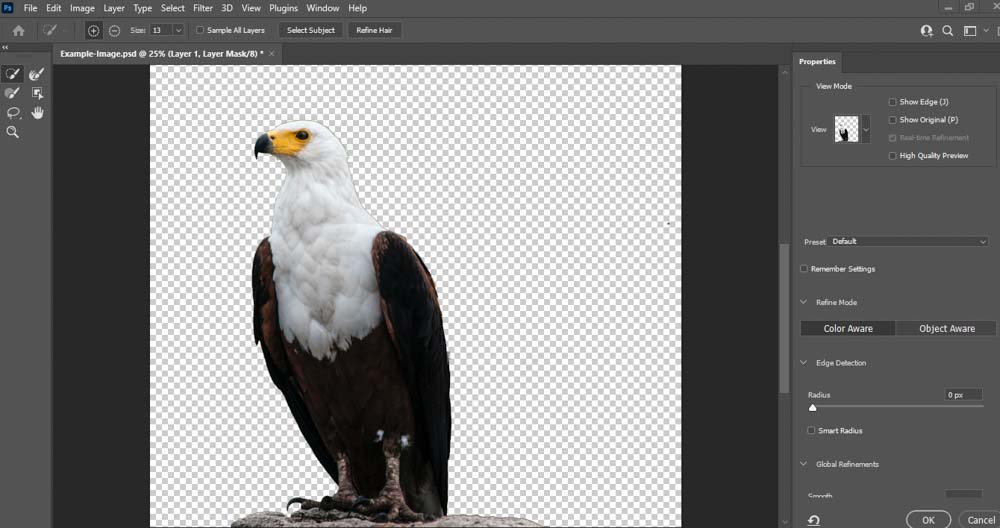
On the right side of the option and mask workspace, for example, you can access the Global Refinements options to refine the edges of your pick.
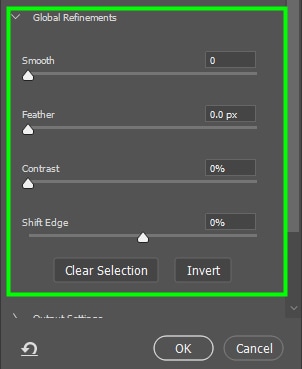
And so, in Decontaminate colors, you lot can get rid of color fringing.
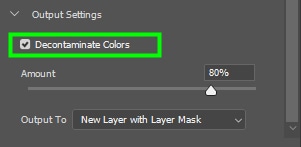
Subsequently sharpening your option, click Ok to exit the Select and Mask workspace.
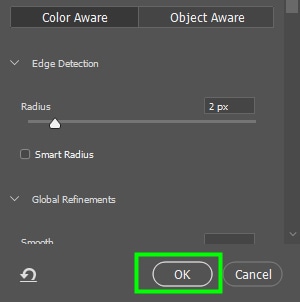
How To Export Your Image With Transparency In Photoshop
Later on making your selection transparent, y'all tin can export your epitome with transparency to employ in other projects.
To exercise that, become to File > Export > Consign Every bit. You can likewise press Alt + Shift + Control + Due west (Win) or Option + Shift + Control + W (Mac).
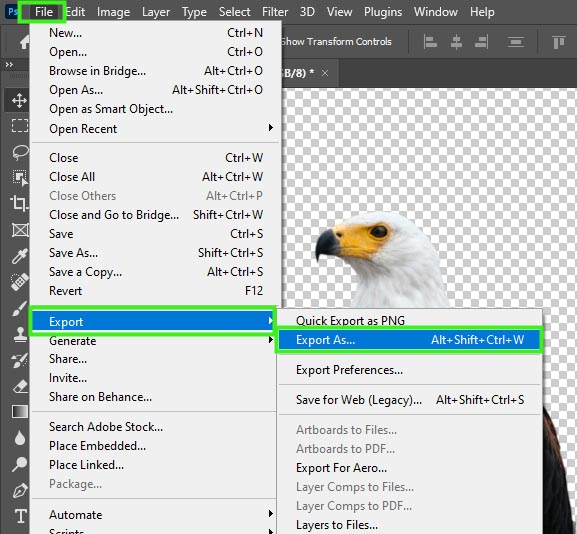
In the Export As console, prepare the Format to PNG, cheque the Transparency checkbox, and click Export to save the file with the settings you lot adjusted.
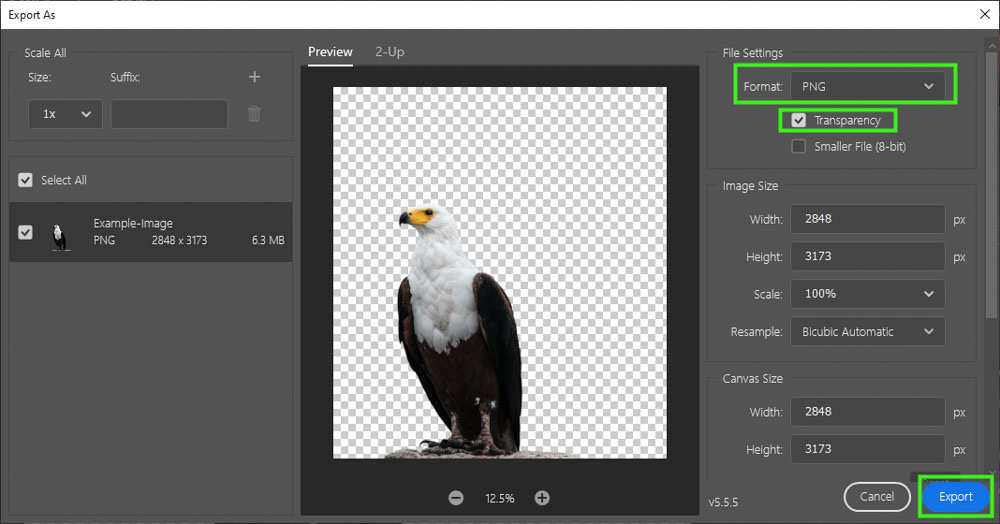
With the assist of these two tools, yous tin chop-chop sample colors and make them transparent in Photoshop whether you lot're working with images, graphics, or text. Just remember that to consign your paradigm with transparency, you must consign every bit PNG to preserve the transparent attributes.
Happy Editing!
How To Change A Black Background To Transparent In Photoshop,
Source: https://www.bwillcreative.com/ways-to-make-any-color-transparent-in-photoshop/
Posted by: smitholaxby.blogspot.com


0 Response to "How To Change A Black Background To Transparent In Photoshop"
Post a Comment